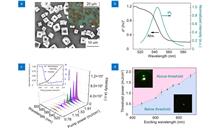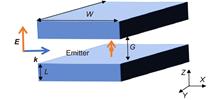 View fulltext
View fulltext
Up-conversion lasing actions are normally difficult to realize in light-emitting materials due to small multi-photon absorption cross section and fast dephasing of excited states during multi-photon excitation. This paper reports an easily accessible up-conversion amplified spontaneous emission (ASE) in organic-inorganic hybrid perovskites (MAPbBr3) films by optically exciting broad gap states with sub-bandgap laser excitation. The broad absorption was optimized by adjusting the grain sizes in the MAPbBr3 films. At low sub-bandgap pumping intensities, directly exciting the gap states leads to 2-photon, 3-photon, and 4-photon up-conversion spontaneous emission, revealing a large optical cross section of multi-photon excitation occurring in such hybrid perovskite films. At moderate pumping intensity (1.19 mJ/cm2) of 700 nm laser excitation, a significant spectral narrowing phenomenon was observed with the full width at half maximum (FWHM) decreasing from 18 nm to 4 nm at the peak wavelength of 550 nm, simultaneously with a nonlinear increase on spectral peak intensity, showing an up-conversion ASE realized at low threshold pumping fluence. More interestingly, the up-conversion ASE demonstrated a giant magnetic field effect, leading to a magneto-ASE reaching 120%. In contrast, the up-conversion photoluminescence (PL) showed a negligible magnetic field effect (< 1%). This observation provides an evidence to indicate that the light-emitting states responsible for up-conversion ASE are essentially formed as spatially extended states. The angular dependent spectrum results further verify the existence of spatially extended states which are polarized to develop coherent in-phase interaction. Clearly, using broad gap states with spatially extended light-emitting states presents a new approach to develop up-conversion ASE in organic-inorganic hybrid perovskites.
The Purcell effect is commonly used to increase the spontaneous emission rate by modifying the local environment of a light emitter. Here, we propose a silicon dielectric cuboid nanoantenna for simultaneously enhancing electric dipole (ED), magnetic dipole (MD) and electric quadrupole (EQ) emission. We study the scattering cross section, polarization charge distribution, and electromagnetic field distribution for electromagnetic plane wave illuminating the silicon dielectric cuboid nanoantenna, from which we have identified simultaneous existence of ED, MD and EQ resonance modes in this nanoantenna. We have calculated the Purcell factor of ED, MD and EQ emitters with different moment orientations as a function of radiation wavelength by placing these point radiation source within the nanoantenna, respectively. We find that the resonances wavelengths of the Purcell factor spectrum are matching with the resonance modes in the nanoantenna. Moreover, the maximum Purcell factor of these ED, MD and EQ emitters is 18, 150 and 118 respectively, occurring at the resonance wavelength of 475, 750, and 562 nm, respectively, all within the visible range. The polarization charge distribution features allow us to clarify the excitation and radiation of these resonance modes as the physical origin of large Purcell factor simultaneously occurring in this silicon cuboid nanoantenna. Our theoretical results might help to deeply explore and design the dielectric nanoantenna as an ideal candidate to enhance ED, MD and EQ emission simultaneously with very small loss in the visible range, which is superior than the more popular scheme of plasmonic nanoantenna.
Laser speckle imaging has been widely used for in-vivo visualization of blood perfusion in biological tissues. However, existing laser speckle imaging techniques suffer from limited quantification accuracy and spatial resolution. Here we report a novel design and implementation of a powerful laser speckle imaging platform to solve the two critical limitations. The core technique of our platform is a combination of line scan confocal microscopy with laser speckle autocorrelation imaging, which is termed Line Scan Laser Speckle Autocorrelation Imaging (LS-LSAI). The technical advantages of LS-LSAI include high spatial resolution (~4.4 μm) for visualizing and quantifying blood flow in microvessels, as well as video-rate imaging speed for tracing dynamic flow.
Orientations of laser induced periodic surface structures (LIPSS) are usually considered to be governed by the laser polarization state. In this work, we unveil that fluid dynamics induced by femtosecond (fs) laser ablation in liquid (fs-LAL) can easily break this polarization restriction to produce irregular circular-LIPSS (CLIPPS) and crisscross-LIPSS (CCLIPSS). Fs laser ablation of silicon in water shows formation of diverse LIPSS depending on ablation conditions. At a high power of 700 mW (repetition rate of 100 kHz, pulse duration of 457 fs and wavelength of 1045 nm), single/twin CLIPSS are produced at the bottom of macropores of several microns in diameter due to the formation of strong liquid vortexes and occurrence of the vortex shedding effect. Theoretical simulations validate our speculation about the formation of liquid vortex with an ultrahigh static pressure, which can induce the microstructure trenches and cracks at the sidewalls for fs-LAL of Si and tungsten (W) in water, respectively. At a low power of 50 mW, weak liquid vortexes are produced, which only give birth to curved LIPSS in the valleys of grooves. Consequently, it is deduced that liquid vortex plays a crucial role in the formation of macropores. Mountain-like microstructures induce complex fluid dynamics which can cause the formation of CCLIPSS on them. It is believed that liquid vortexes and fluid dynamics presented in this work open up new possibilities to diversify the morphologies of LIPSS formed by fs-LAL.












